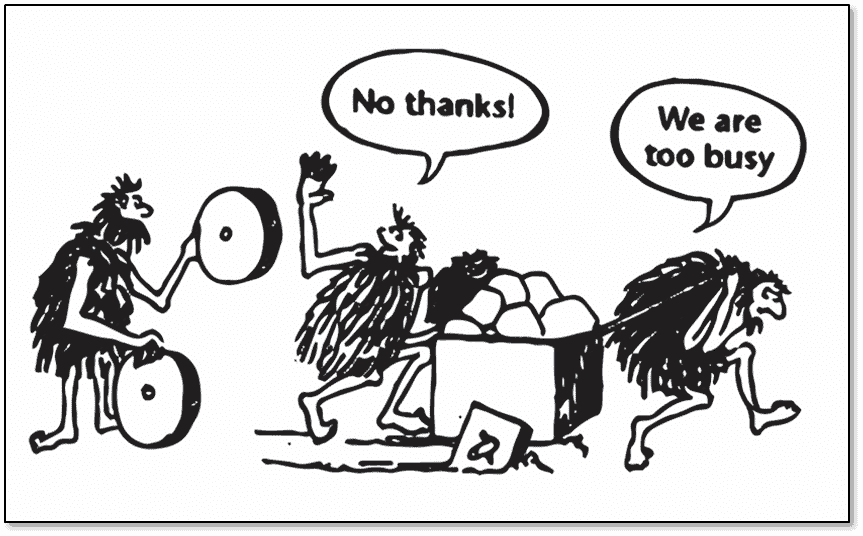In our daily work at Ten Mile Square, we hear story after story of business challenges with products, technology, inter-departmental dynamics, or some combination of all of the above. Sometimes the people relating these issues decide to do nothing about them in the short-term citing ongoing pressures to deliver results.

The “helpful” caveman with the round wheels misunderstands the objective, so his offering is disruptive, not an innovation.
This cartoon, the cavemen with square wheels has been used all over blogs and LinkedIn posts for pontificating on failures to innovate, and even on the nature of why the square wheel cavemen might be right. I use it here because it depicts the leading reason why many don’t act, some even acknowledging that they “know” not doing anything is probably bad. This has forced me to evaluate this behavior, not with judgment, as the cartoon wants, but with empathy for what motivates this decision. I’ve come to the conclusion that sometimes in the beholder’s eye, the understood risks of doing nothing are more palatable than the abstract risks associated with initiating and executing change.
So now the question is, why is that, what are the underlying motivators that lead to this judgment of risk and the decision to stay the course. When I peel back the onion, a small number of items emerge as powerful motivators:
- Slows me down: Some are concerned that the overhead of bringing in an outside party plus the activities associated with whatever the problem statement is will slow them down at a critical time. This is especially true of entrepreneurial executives that are executing at break-neck speed. It’s not just the time to change the wheel, the cart has to be stopped, unloaded, reloaded, etc. What if the axle holes don’t fit and need to be “integrated”?
- Fear of disruption: What if the busy cavemen aren’t trying to get their load of rocks to market, but are instead plowing the earth, depending on the square “wheels” to create ruts and the rocks for weight. The “helpful” caveman with the round wheels misunderstands the objective, so his offering is disruptive, not an innovation. What the cavemen need is a harrow, but they feel they don’t have the time to explain their intent.
- Timing is wrong: There may be a sense that the current effort is just about to yield results, or like the cartoon as intended, everyone is too busy on the task at hand to look at a potentially better solution.
- Unknown/Unproven: The round wheel caveman is simply holding up some parts, there is no evidence that what he offers is an improvement over the current method. It seems obvious to us round wheel aficionados, but what if you’d never seen one before? The risk of spending time, money, and energy on a path that is uncertain in the estimation of the buyer is difficult to overcome.
- Potential for loss of control: When you are used to calling the shots, a 3rd party change agent can represent an existential risk, even when they are there to help you with your stated goals and objectives. Who’s to say those wheels have brakes on them?
At Ten Mile Square, we tend to like evidence-based past performance and an opportunity to spend an hour working with you on a current challenge in order to prove our case. Give us a call if you’d like to learn more.